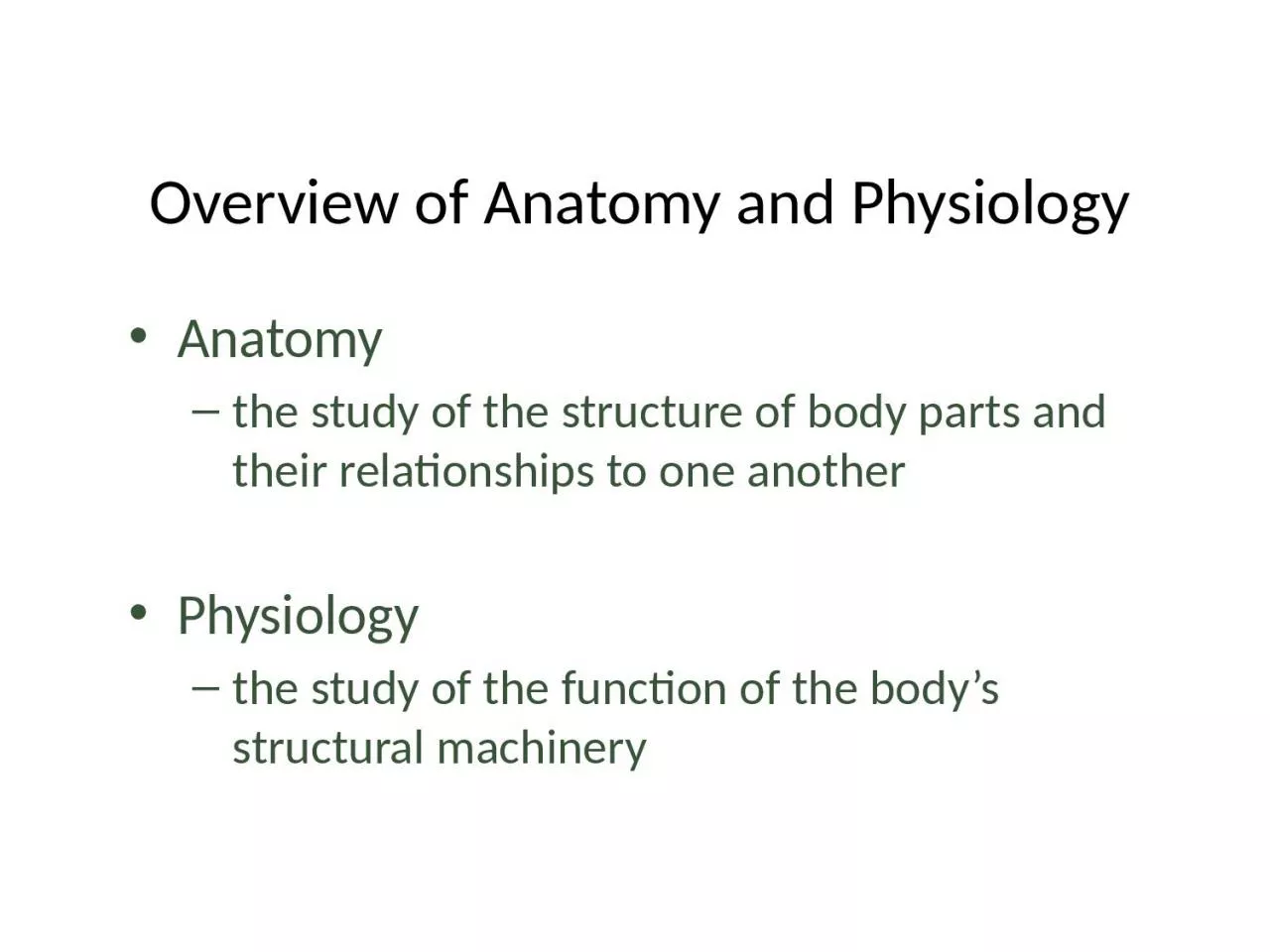

Anatomy the study of the structure of body parts and their relationships to one another Physiology the study of the function of the bodys structural machinery Overview of Anatomy and Physiology ID: 935890
Download Presentation The PPT/PDF document "Overview of Anatomy and Physiology" is the property of its rightful owner. Permission is granted to download and print the materials on this web site for personal, non-commercial use only, and to display it on your personal computer provided you do not modify the materials and that you retain all copyright notices contained in the materials. By downloading content from our website, you accept the terms of this agreement.
Slide1
Overview of Anatomy and Physiology
Anatomy
the study of the structure of body parts and their relationships to one another
Physiology
the study of the function of the body’s structural machinery
Slide2Overview of Anatomy and Physiology
Anatomy
Subdivisions:
Gross or macroscopic
regional, surface, and systemic anatomy
Microscopic
cytology and histology
Developmental
Embryology
Slide3Levels of Structural Organization
Chemical:
atoms and molecules (Chapter 2)
Cellular:
cells and their organelles (Chapter 3)
Tissue:
groups of similar cells (Chapter 4)
Organ:
contains two or more types of tissues
Organ system:
organs that work closely together
Organismal
:
all organ systems
Slide4Cardiovascular
system
Organelle
Molecule
Atoms
Chemical level
Atoms combine to form molecules.
Cellular level
Cells are made up of
molecules.
Tissue level
Tissues consist of similar
types of cells.
Organ level
Organs are made up of different types
of tissues.
Organ system level
Organ systems consist of different
organs that work together closely.
Organismal level
The human organism is made up
of many organ systems.
Smooth muscle cell
Smooth muscle tissue
Connective tissue
Blood vessel (organ)
Heart
Blood
vessels
Epithelial
tissue
Smooth muscle tissue
1
2
3
4
5
6
Figure 1.1, step 6
Slide5Necessary Life Functions
Maintaining boundaries between internal and external environments
Plasma membranes
Skin
Movement (contractility)
Of body parts (skeletal muscle)
Of substances (cardiac and smooth muscle)
Slide6Necessary Life Functions
Responsiveness: The ability to sense and respond to stimuli
Withdrawal reflex
Control of breathing rate
Digestion
Breakdown of ingested foodstuffs
Absorption of simple molecules into blood
Slide7Necessary Life Functions
Metabolism: All chemical reactions that occur in body cells
Catabolism and anabolism
Excretion: The removal of wastes from metabolism and digestion
Urea, carbon dioxide, feces
Slide8Necessary Life Functions
Reproduction
Cellular division for growth or repair
Production of offspring
Growth: Increase in size of a body part or of organism
Slide9Survival Needs
Nutrients
Chemicals for energy and cell building
Carbohydrates, fats, proteins, minerals, vitamins
Oxygen
Essential for energy release (ATP production)
Slide10Survival Needs
Water
Most abundant chemical in the body
Site of chemical reactions
Normal body temperature
Affects rate of chemical reactions
Appropriate atmospheric pressure
For adequate breathing and gas exchange in the lungs
Slide11Homeostasis
Maintenance of a relatively stable internal environment despite continuous outside changes
A dynamic state of equilibrium
Slide12Components of a Control Mechanism
Receptor (sensor)
Monitors the environment
Responds to stimuli (changes in controlled variables)
Control center
Determines the set point at which the variable is maintained
Receives input from receptor
Determines appropriate response
Slide13Components of a Control Mechanism
Effector
Receives output from control center
Provides the means to respond
Response acts to reduce or enhance the stimulus (feedback)
Slide14Negative Feedback
The response reduces or shuts off the original stimulus
Examples:
Regulation of body temperature
a nervous mechanism
Regulation of blood volume by ADH
an endocrine mechanism
Slide15Positive Feedback
The response enhances or exaggerates the original stimulus
May exhibit a cascade or amplifying effect
Usually controls infrequent events e.g.:
Enhancement of labor contractions by oxytocin (Chapter 28)
Platelet plug formation and blood clotting
Slide16Homeostatic Imbalance
Disturbance of homeostasis
Increases risk of disease
Contributes to changes associated with aging
May allow destructive positive feedback mechanisms to take over (e.g., heart failure)